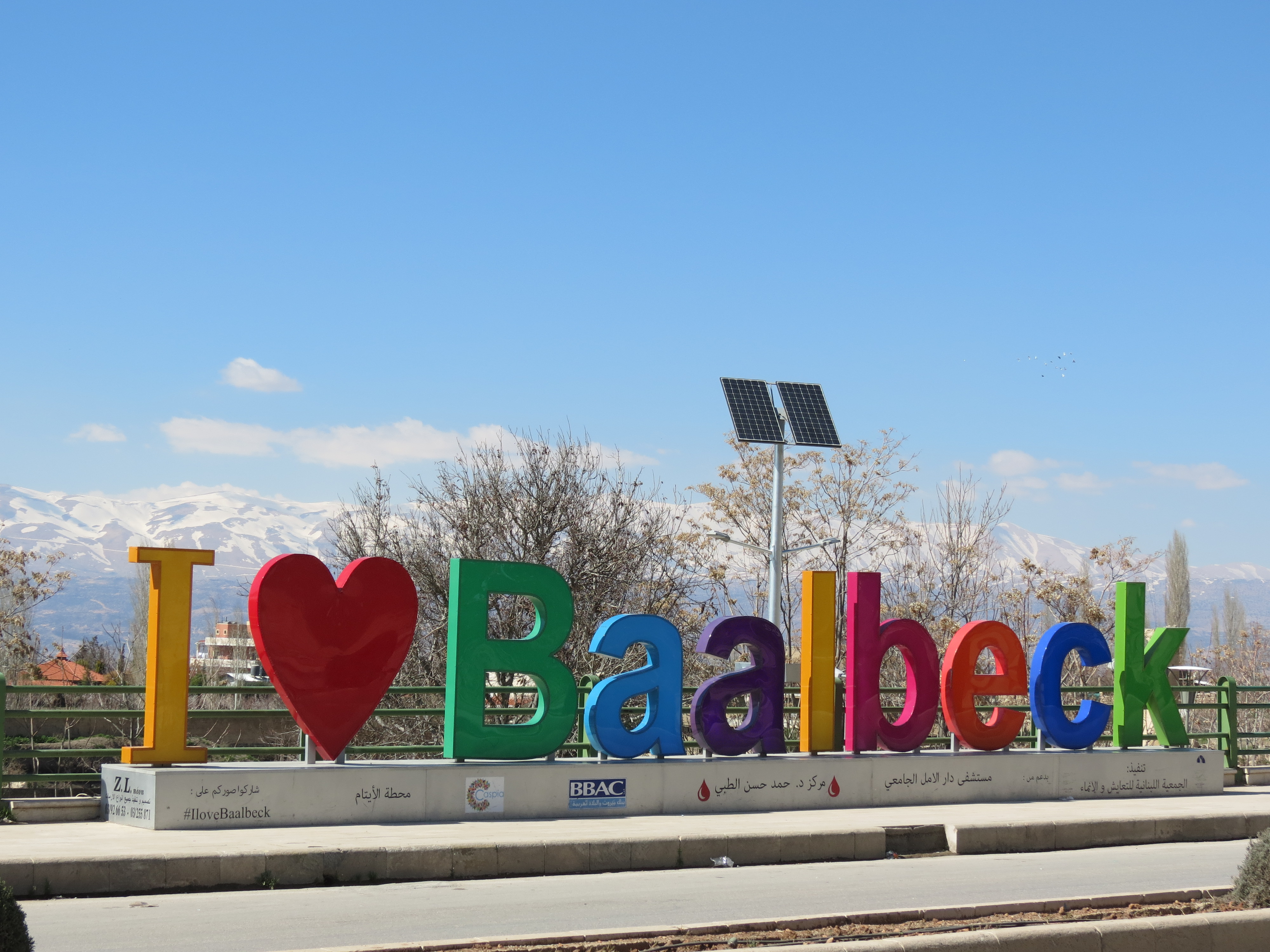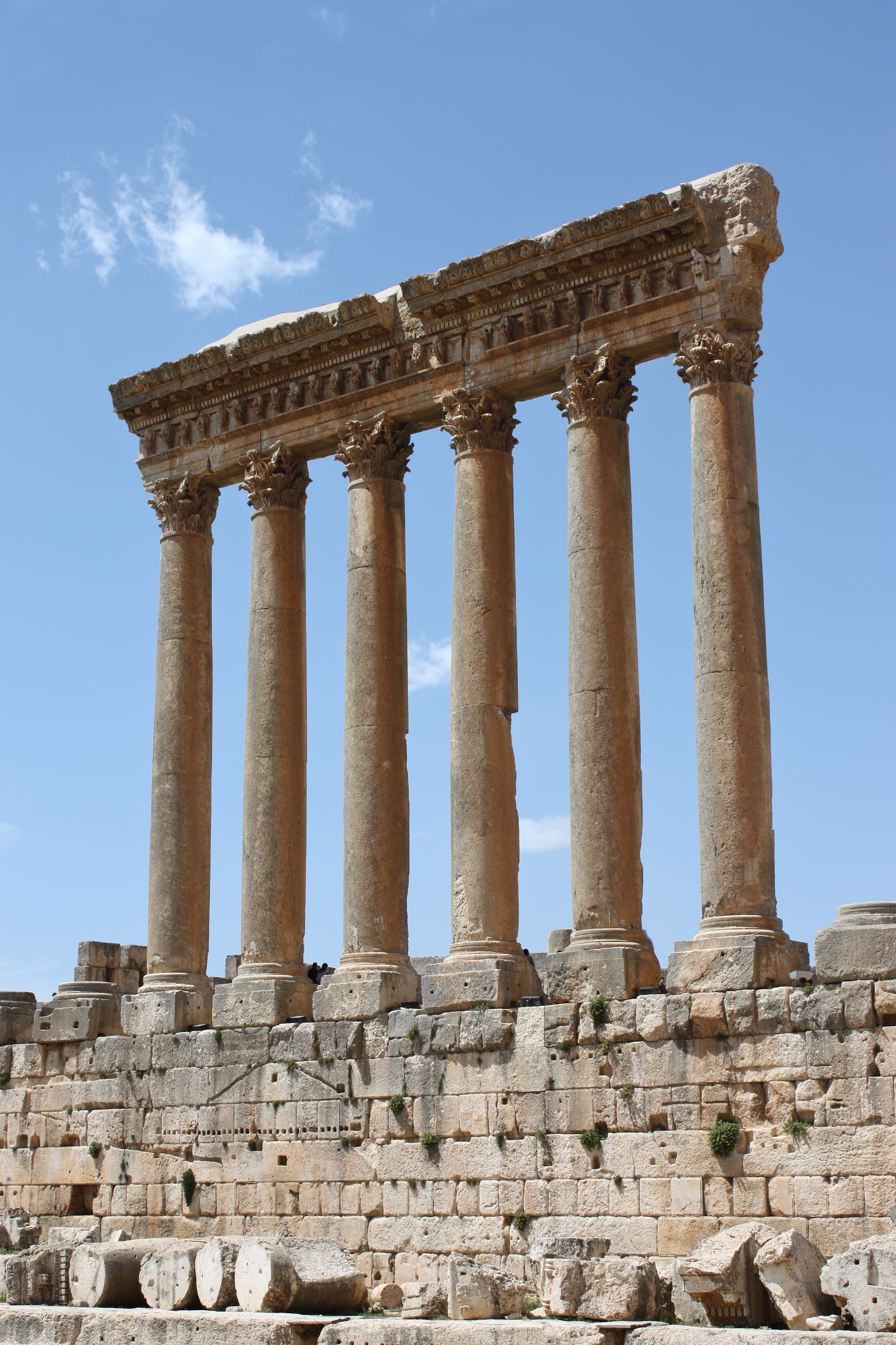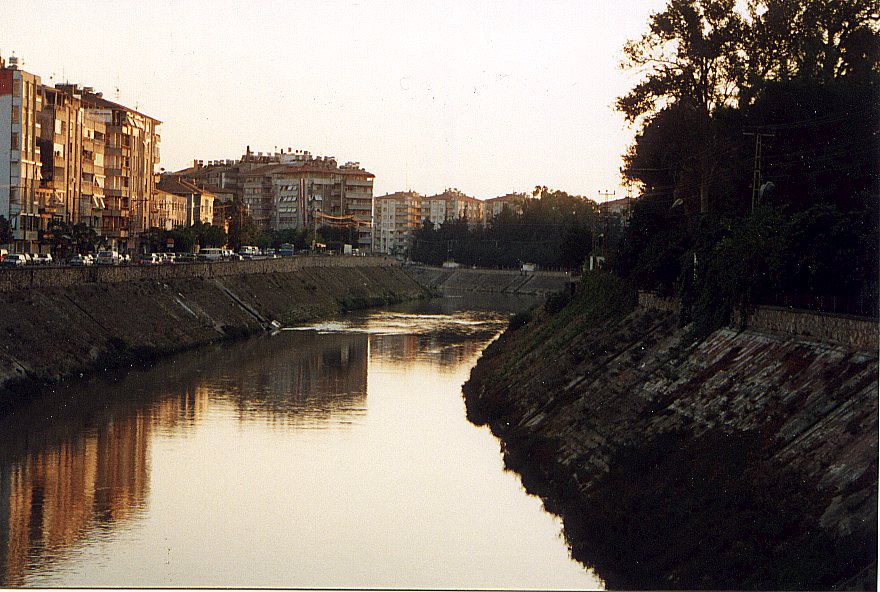|
Heliopolis (Syria)
Baalbek (; ar, بَعْلَبَكّ, Baʿlabakk, Syriac-Aramaic: ܒܥܠܒܟ) is a city located east of the Litani River in Lebanon's Beqaa Valley, about northeast of Beirut. It is the capital of Baalbek-Hermel Governorate. In Greek and Roman times Baalbek was also known as Heliopolis (, Greek for "Sun City"). In 1998 Baalbek had a population of 82,608, mostly Shia Muslims, followed by Sunni Muslims and Christians. It is home to the Baalbek temple complex which includes two of the largest and grandest Roman temple ruins: the Temple of Bacchus and the Temple of Jupiter. It was inscribed in 1984 as an UNESCO World Heritage site. Name A few miles from the swamp from which the Litani (the classical Leontes) and the Asi (the upper Orontes) flow, Baalbek may be the same as the ''manbaa al-nahrayn'' ("Source of the Two Rivers"), the abode of El in the Ugaritic Baal Cycle discovered in the 1920s and a separate serpent incantation. Baalbek was called Heliopolis during the Roman ... [...More Info...] [...Related Items...] OR: [Wikipedia] [Google] [Baidu] |
Balbec, Indiana
Balbec is an unincorporated area, unincorporated community in Penn Township, Jay County, Indiana, Penn Township, Jay County, Indiana, Jay County, Indiana. History A post office was established at Balbec in 1865, and remained in operation until it was discontinued in 1919. The community was likely named after Baalbek, in Lebanon. References [...More Info...] [...Related Items...] OR: [Wikipedia] [Google] [Baidu] |
Temple Of Jupiter, Baalbek
The Temple of Jupiter is a colossal Roman temple, the largest of the Roman world, situated at the Baalbek complex in Heliopolis Syriaca (modern Lebanon). The temple served as an oracle and was dedicated to Jupiter Heliopolitanus. It is not known who commissioned or designed the temple, nor exactly when it was constructed. Work probably began around 16 BC and was nearly complete by about AD 60. It is situated at the western end of the Great Court of Roman Heliopolis, on a broad platform of stone raised another above the huge stones of the foundation, three of which are among the heaviest blocks ever used in a construction. Cultic activity had long taken place at the site; the temple presumably replaced an earlier one, possibly using the same foundation. It was the biggest temple dedicated to Jupiter in all the Roman Empire. The columns were 19.9 meters high with a diameter of nearly 2.5 meters: the biggest in the classical world. It took three centuries to create this colo ... [...More Info...] [...Related Items...] OR: [Wikipedia] [Google] [Baidu] |
Seleucids
The Seleucid Empire (; grc, Βασιλεία τῶν Σελευκιδῶν, ''Basileía tōn Seleukidōn'') was a Greek state in West Asia that existed during the Hellenistic period from 312 BC to 63 BC. The Seleucid Empire was founded by the Macedonian general Seleucus I Nicator, following the division of the Macedonian Empire originally founded by Alexander the Great. After receiving the Mesopotamian region of Babylonia in 321 BC, Seleucus I began expanding his dominions to include the Near Eastern territories that encompass modern-day Iraq, Iran, Afghanistan, Syria, all of which had been under Macedonian control after the fall of the former Persian Achaemenid Empire. At the Seleucid Empire's height, it had consisted of territory that had covered Anatolia, Persia, the Levant, and what are now modern Iraq, Kuwait, Afghanistan, and parts of Turkmenistan. The Seleucid Empire was a major center of Hellenistic culture. Greek customs and language were privileged; the wide variet ... [...More Info...] [...Related Items...] OR: [Wikipedia] [Google] [Baidu] |
Sun Worship
A solar deity or sun deity is a deity who represents the Sun, or an aspect of it. Such deities are usually associated with power and strength. Solar deities and Sun worship can be found throughout most of recorded history in various forms. The Sun is sometimes referred to by its Latin name ''Sol'' or by its Greek language, Greek name ''Helios''. The English language, English word ''sun'' derives from Proto-Germanic *''sunnǭ''. Overview Prehistoric Egypt, Predynasty Egyptian beliefs attribute Atum as the Sun god and Horus as god of the sky and Sun. As the Old Kingdom theocracy gained influence, early beliefs were incorporated into the expanding popularity of Ra and the Osiris-Horus mythology. Atum became Ra-Atum, the rays of the setting Sun. Osiris became the divine heir to Atum's power on Earth and passed his divine authority to his son, Horus. Other early Egyptian myths imply that the Sun is incorporated with the lioness Sekhmet at night and is reflected in her eyes; or th ... [...More Info...] [...Related Items...] OR: [Wikipedia] [Google] [Baidu] |
Hellenistic Period
In Classical antiquity, the Hellenistic period covers the time in Mediterranean history after Classical Greece, between the death of Alexander the Great in 323 BC and the emergence of the Roman Empire, as signified by the Battle of Actium in 31 BC and the conquest of Ptolemaic Egypt the following year. The Ancient Greek word ''Hellas'' (, ''Hellás'') was gradually recognized as the name for Greece, from which the word ''Hellenistic'' was derived. "Hellenistic" is distinguished from "Hellenic" in that the latter refers to Greece itself, while the former encompasses all ancient territories under Greek influence, in particular the East after the conquests of Alexander the Great. After the Macedonian invasion of the Achaemenid Empire in 330 BC and its disintegration shortly after, the Hellenistic kingdoms were established throughout south-west Asia ( Seleucid Empire, Kingdom of Pergamon), north-east Africa ( Ptolemaic Kingdom) and South Asia ( Greco-Bactrian Kingdom, Indo-Greek ... [...More Info...] [...Related Items...] OR: [Wikipedia] [Google] [Baidu] |
Ancient Greek Language
Ancient Greek includes the forms of the Greek language used in ancient Greece and the classical antiquity, ancient world from around 1500 BC to 300 BC. It is often roughly divided into the following periods: Mycenaean Greek (), Greek Dark Ages, Dark Ages (), the Archaic Greece, Archaic period (), and the Classical Greece, Classical period (). Ancient Greek was the language of Homer and of fifth-century Athens, fifth-century Athenian historians, playwrights, and Ancient Greek philosophy, philosophers. It has contributed many words to English vocabulary and has been a standard subject of study in educational institutions of the Western world since the Renaissance. This article primarily contains information about the Homeric Greek, Epic and Classical periods of the language. From the Hellenistic period (), Ancient Greek was followed by Koine Greek, which is regarded as a separate historical stage, although its earliest form closely resembles Attic Greek and its latest form a ... [...More Info...] [...Related Items...] OR: [Wikipedia] [Google] [Baidu] |
Latinization Of Names
Latinisation (or Latinization) of names, also known as onomastic Latinisation, is the practice of rendering a ''non''-Latin name in a Latin style. It is commonly found with historical proper names, including personal names and toponyms, and in the standard binomial nomenclature of the life sciences. It goes further than romanisation, which is the transliteration of a word to the Latin alphabet from another script (e.g. Cyrillic). For authors writing in Latin, this change allows the name to function grammatically in a sentence through declension. In a scientific context, the main purpose of Latinisation may be to produce a name which is internationally consistent. Latinisation may be carried out by: * transforming the name into Latin sounds (e.g. for ), or * adding Latinate suffixes to the end of a name (e.g. for '' Meibom),'' or * translating a name with a specific meaning into Latin (e.g. for Italian ; both mean 'hunter'), or * choosing a new name based on some attribut ... [...More Info...] [...Related Items...] OR: [Wikipedia] [Google] [Baidu] |
Roman Empire
The Roman Empire ( la, Imperium Romanum ; grc-gre, Βασιλεία τῶν Ῥωμαίων, Basileía tôn Rhōmaíōn) was the post-Republican period of ancient Rome. As a polity, it included large territorial holdings around the Mediterranean Sea in Europe, North Africa, and Western Asia, and was ruled by emperors. From the accession of Caesar Augustus as the first Roman emperor to the military anarchy of the 3rd century, it was a Principate with Italia as the metropole of its provinces and the city of Rome as its sole capital. The Empire was later ruled by multiple emperors who shared control over the Western Roman Empire and the Eastern Roman Empire. The city of Rome remained the nominal capital of both parts until AD 476 when the imperial insignia were sent to Constantinople following the capture of the Western capital of Ravenna by the Germanic barbarians. The adoption of Christianity as the state church of the Roman Empire in AD 380 and the fall of the Western ... [...More Info...] [...Related Items...] OR: [Wikipedia] [Google] [Baidu] |
Baal Cycle
The Baal Cycle is an Ugaritic cycle of stories about the Canaanite god Baʿal ( "Owner", "Lord"), a storm god associated with fertility. It is one of the Ugarit texts, dated to c. 1500-1300 BCE. The text identifies Baal as the god Hadad, the Northwest Semitic form of Adad. The stories are written in Ugaritic, a Northwest Semitic language, and written in a cuneiform consonantal alphabet. It was discovered on a series of clay tablets found in the 1920s in the Tell of Ugarit (modern Ras Shamra), situated on the Mediterranean coast of northern Syria, a few kilometers north of the modern city of Latakia and far ahead of the current coastline. The stories include ''The Myth of Baʿal Aliyan'' and ''The Death of Baʿal''. Basic synopsis The Baʿal Cycle series of stories are summarized as: * Yam wants to rule over the other gods and be the most powerful of all * Baʿal Hadad opposes Yam and slays him * Baʿal Hadad, with the help of Anat and Athirat, persuades El to allow him ... [...More Info...] [...Related Items...] OR: [Wikipedia] [Google] [Baidu] |
Ugaritic Religion
The Canaanite religion was the group of ancient Semitic religions practiced by the Canaanites living in the ancient Levant from at least the early Bronze Age through the first centuries AD. Canaanite religion was polytheistic and, in some cases, monolatristic. Beliefs Deities A group of deities in a four-tier hierarchy headed by El and Asherah were worshiped by the followers of the Canaanite religion; this is a detailed listing: * Aglibol, god of the moon and brother of Malakbel. Part of a trio of gods of Palmyra, Syria along with Bel and Yarhibol. Also part of another trio with Baalshamin and Malakbel. * Anat, virgin goddess of war and strife, sister and putative mate of Ba'al Hadad. * Arsay, goddess of the underworld, one of the three daughters of Ba'al Hadad. * Arsu, god of the evening star and twin brother of Azizos. * Ashtar-Chemosh, wife of Chemosh and goddess of the Moabites. * Asherah, queen consort of El (Ugaritic religion), Elkunirsa (Hittite religion), Yahweh ( ... [...More Info...] [...Related Items...] OR: [Wikipedia] [Google] [Baidu] |
El (god)
(also Il, uga, 𐎛𐎍 ''ʾīlu''; phn, 𐤀𐤋 ''ʾīl''; he, אֵל ''ʾēl''; syr, ܐܺܝܠ ''ʾīyl''; ar, إيل or ; cognate to akk, 𒀭, ilu) is a Northwest Semitic word meaning "god" or "deity", or referring (as a proper name) to any one of multiple major ancient Near Eastern deities. A rarer form, ''ila'', represents the predicate form in Old Akkadian and in Amorite. The word is derived from the Proto-Semitic *ʔil-, meaning "god". Specific deities known as ''El'', ''Al'' or ''Il'' include the supreme god of the ancient Canaanite religion and the supreme god of East Semitic speakers in Mesopotamia's Early Dynastic Period. Among the Hittites, El was known as Elkunirsa. Linguistic forms and meanings Cognate forms of ʼĒl are found throughout the Semitic languages. They include Ugaritic , pl. ; Phoenician pl. ; Hebrew , pl. ; Aramaic ; Akkadian , pl. . In northwest Semitic use, ʼĒl was a generic word for any god as well as the special name or tit ... [...More Info...] [...Related Items...] OR: [Wikipedia] [Google] [Baidu] |
Orontes River
The Orontes (; from Ancient Greek , ) or Asi ( ar, العاصي, , ; tr, Asi) is a river with a length of in Western Asia that begins in Lebanon, flowing northwards through Syria before entering the Mediterranean Sea near Samandağ in Turkey. As the chief river of the northern Levant, the Orontes was the site of several major battles. Among the most important cities on the river are Homs, Hama, Jisr al-Shughur, and Antakya (the ancient Antioch, which was also known as "Antioch on the Orontes"). Names In the 9th century BCE, the ancient Assyrians referred to the river as Arantu, and the nearby Egyptians called it Araunti. The etymology of the name is unknown, yet some sources indicate that it might be derived from ''Arnt'' which means "lioness" in Syriac languages; others called it ''Alimas'', a "water goddess" in Aramaic. However, ''Arantu'' gradually became "Orontes" in Greek. In the Greek epic poem '' Dionysiaca'' (circa 400 CE), the river is said to have been named after ... [...More Info...] [...Related Items...] OR: [Wikipedia] [Google] [Baidu] |









